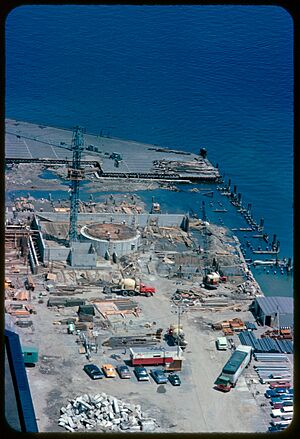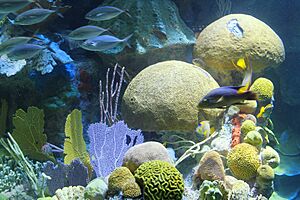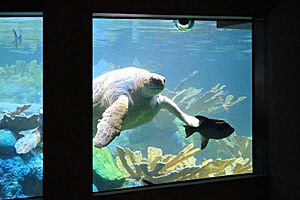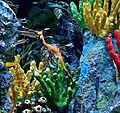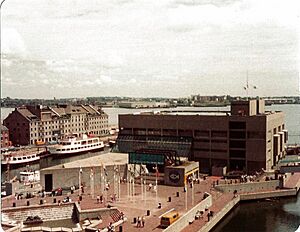New England Aquarium facts for kids
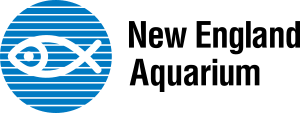 |
|
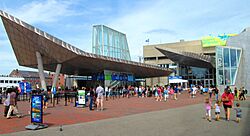
New England Aquarium plaza (2017)
|
|
| Date opened | June 20, 1969 |
|---|---|
| Location | Central Wharf, Boston, Massachusetts |
| Land area | 75,000 square feet (7,000 m2) |
| Coordinates | 42°21′33″N 71°2′58″W / 42.35917°N 71.04944°W |
| Volume of largest tank | 200,000 US gallons (760,000 L) |
| Annual visitors | 1.3 million |
The New England Aquarium is a special place in Boston, Massachusetts, where you can explore the amazing world under the sea! It's a nonprofit organization, which means it works to protect our oceans and the animals in them.
At the aquarium, you can see many cool creatures. These include harbor and northern fur seals, California sea lions, and different kinds of penguins. You might also spot giant Pacific octopuses, weedy seadragons, and thousands of colorful fish.
Besides the main building, there's also the Simons Theatre and the New England Aquarium Whale Watch. Before 2020, over 1.3 million people visited the aquarium every year!
The Anderson Cabot Center for Ocean Life, part of the aquarium, studies animals like the North Atlantic right whale. They also have a special center in Quincy that helps rescue and heal hundreds of sea turtles each year.
Contents
History of the Aquarium
Boston has had aquariums since the 1880s. The one before the New England Aquarium closed in the 1950s.
In 1962, plans began for a new, modern aquarium. This was part of a city goal to make the waterfront a better place. The building was designed by Peter Chermayeff. It opened to the public in 1969. The Giant Ocean Tank, a huge 200,000-US-gallon (760,000 L) cylindrical tank, opened in 1970.
In 1974, a large boat called Discovery was docked next to the aquarium. It was like a floating addition! It had a 1,000-seat amphitheater and a big saltwater pool. California sea lions and bottlenose dolphins used to perform there. The Discovery was taken out of service in the mid-2000s because it was getting old and expensive to keep.
A new part of the building, called the West Wing, was finished in 1998. This new section was made of glass and steel. It also added a new gift shop and a café with harbor views.
The Matthew and Marcia Simons Theatre opened in 2001. It's in a separate building on Central Wharf. In 2020, the theatre was updated with a new digital projector. It can show 2D and 3D films on its large 80-foot (24 m) by 43-foot (13 m) screen. Also in 2020, artist Shepard Fairley painted a mural on the theatre's outside wall. It shows a North Atlantic right whale.
In 2009, the New Balance Foundation Marine Mammal Center opened. This outdoor exhibit lets visitors see the aquarium's California sea lions and northern fur seals. You can even see them from outside the building!
A new Animal Care Center opened in 2010. This 23,000-square-foot (2,100 m2) facility is in Quincy. It has large tanks to hold animals during exhibit repairs. It also helps new animals get used to their new home. Most importantly, it helps heal rescued sea turtles.
In 2011, the aquarium added an Australian Great Southern Reef exhibit. It features leafy and weedy seadragons. The aquarium also started its own captive breeding program for these special creatures.
From 2007 to 2013, the aquarium made big improvements to the Giant Ocean Tank. They added a larger coral reef and bigger viewing windows. They also put in new lighting. The Yawkey Coral Reef Center was added at the top of the exhibit. During these updates, the Giant Ocean Tank's animals lived in the penguin habitat. The penguins moved to the Quincy Animal Care Center for a while.
In 2019, the aquarium updated the Indo-Pacific coral reef tank. They replaced it with a new, tall exhibit. It has an artificial coral habitat based on the Phoenix Islands Protected Area. The aquarium helped create this protected area.
Leadership
The current President and CEO of the aquarium is Vikki Spruill. She started this job on July 30, 2018. She works with Kim Fontes, the Chief of Staff, and Lauren Hunter-Dyson, the Chief People and Diversity Officer. John Mandelman, Ph.D., leads the Anderson Cabot Center for Ocean Life.
Exhibits
Giant Ocean Tank
The Giant Ocean Tank is the main attraction at the aquarium. It's in the middle of the building. This huge 200,000-US-gallon (760,000 L) tank looks like a Caribbean coral reef.
Its permanent residents include Myrtle the green sea turtle, loggerhead sea turtles, and hundreds of colorful tropical fish. You might also see reef-dwelling sharks, stingrays, and moray eels. A spiral walkway goes around the tank. This lets you see the animals from all angles through 67 clear windows.
Marine Mammals
You can see the Atlantic harbor seal exhibit at the front of the main building for free! Five seals live there. The New Balance Foundation Marine Mammal Center is at the back of the building. It's home to three California sea lions and one northern fur seal. You can also view them from outside, from the Harborwalk.
Penguins
At the bottom of the Giant Ocean Tank is a 150,000-US-gallon (570,000 L) saltwater pool for penguins. This is where African and southern rockhopper penguins live. They have artificial rock islands to play on. You can watch them from the spiral walkway and other areas around the tank.
Galleries
Around the Giant Ocean Tank, there are four levels of smaller exhibits. You can reach them by a spiral ramp or other ramps.
- The Tropical Gallery has live corals and many warm-water fish. It includes a tall, 9,000-US-gallon (34,000 L) Indo-Pacific coral reef exhibit.
- The Temperate Gallery features goliath groupers, lungfish, weedy seadragons, and sea jellies.
- The Freshwater Gallery shows aquatic habitats from the Amazon and the Connecticut River Valley. You can see red-bellied piranhas, poison dart frogs, a green anaconda, and an electric eel.
- The Northern Waters Gallery compares marine habitats in New England and the Pacific Northwest. It has shorebirds, colorful American lobsters, and a giant Pacific octopus.
- The Yawkey Coral Reef Center is at the top of the Giant Ocean Tank. It shows smaller habitats from Caribbean waters. You can see dwarf seahorses and garden eels there.
Shark and Ray Touch Tank

In 2011, the 25,000 US gallons (95,000 L) Trust Family Foundation Shark and Ray Touch Tank became a permanent exhibit. It's in the aquarium's West Wing. Here, you can gently touch different kinds of stingrays and sharks. These include leopard whiprays and brown-banded bamboo sharks. The lower level of the West Wing also has a special exhibit called "Science of Sharks." It teaches you about shark bodies, how they have babies, and how many different kinds there are.
Special Programs
The aquarium has had special educational programs over the years. These often highlight certain animals.
Penguin Power
In 2010, "Penguin Power" focused on the aquarium's penguins. Visitors learned how penguins survive in the wild. They also learned how to help protect them.
Move It! Marine Mammals in Motion
This program started in 2009 when the New Balance Foundation Marine Mammal Center opened. It showed how athletic the aquarium's harbor seals, sea lions, and fur seals are. It also encouraged young visitors to be active themselves. The Marine Mammal Center still teaches about marine mammals and the challenges they face in our oceans.
Turtles Uncovered
In 2008, this exhibit taught visitors that turtles have lived on Earth for about 300 million years. That's even before the dinosaurs! But now, some turtles are in danger. This is due to pollution, losing their homes, and climate change.
Killer Instincts
This special program in 2007 helped visitors learn about animals that people often fear. It included interactive activities and live animal shows. There was also a big video about sharks. Animals featured included the sand tiger shark, anaconda, great barracuda, electric eel, lionfish, moray eel, giant Pacific octopus, and southern stingray.
Conservation Efforts
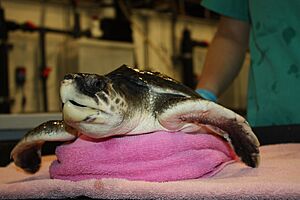
The aquarium has a long history of rescuing marine mammals along the New England coast. The harbor seals you see today were born to seals rescued long ago. The California sea lions and northern fur seal were rescued on the West Coast and Alaska. They couldn't be released back into the wild. In 1999, the aquarium opened a new place in Duxbury to help harbor porpoises.
Over time, the number of marine mammals like Atlantic harbor seals grew. So, the aquarium changed its focus. Now, they do more research and speak up for animals. They especially help the critically endangered North Atlantic right whale. They also rescue, heal, and release cold-stunned sea turtles found on Cape Cod.
The aquarium is part of the Association of Zoos and Aquariums (AZA). It helps with plans to save African and southern rockhopper penguins. These penguins are losing their homes in the wild. The aquarium also raises some of its own exhibit animals and food for them.

The aquarium has spoken out about climate change, fishing practices, and protecting marine animals. They work with some large seafood companies to help them be more sustainable. The aquarium has also suggested new ways of fishing for lobster to protect North Atlantic right whales. They also provide research for offshore wind farms.
In the 1970s and 80s, the aquarium and other groups worked to clean up Boston Harbor and the Charles River. Their efforts were successful, making the waters safe for fishing and swimming again.
Whale Watch
From April to October, the aquarium teams up with Boston Harbor Cruises. They take people on whale watching trips about 30 miles (48 km) east of Boston. This area is called the Stellwagen Bank Marine Sanctuary. On the boats, naturalists teach you about the whales. You are almost guaranteed to see whales and other marine animals! This area is a rich feeding ground for humpback whales, finback whales, minke whales, pilot whales, and pods of dolphins. You might even see the endangered North Atlantic right whale. Most trips last about 3 to 4 hours. If no whales are seen, you get a voucher for another trip.
Images for kids
-
IMAX theatre at the aquarium.
-
Sea jellies on display.
-
Moray eel at the aquarium.
-
Earth Day community event on climate change.
-
Ocellate river stingray (Potamotrygon motoro)
-
The aquarium working with the United States Coast Guard to transport endangered sea turtles.
Cancelled Expansions
In 1988, the aquarium planned to move to the Charlestown Navy Yard. This new facility would have been much larger. It would have had a huge exhibit for dolphins and pilot whales. The project was expected to attract 2 million visitors each year. However, the move was cancelled in 1991. People living nearby didn't want it built. Also, the aquarium couldn't sell its Central Wharf location for enough money.
After the Charlestown plan was cancelled, the aquarium decided to expand its current location. In 1992, they proposed adding a West Wing and an East Wing. The East Wing would have been a large addition with a huge Gulf Stream exhibit. It would also have had a big window into a new Gulf of Maine exhibit.
This project was supposed to be finished by 2004. But the East Wing was cancelled. This was due to events like the September 11th attacks, which made people worried about crowded places. Also, the nearby Aquarium MBTA station closed for a while. The cost of the project also grew very high. To pay back money they had raised, the aquarium had to cut its budget and staff. Because of this, the aquarium lost its special accreditation in 2003. But they earned it back in 2006!
See also
- Hoover, a harbor seal at the aquarium who learned to imitate human speech
- Andre, a harbor seal who lived at the aquarium but swam back to Rockport, Maine every summer
- Brian Skerry, the aquarium’s Explorer-in-Residence
- Sy Montgomery, author of The Soul of an Octopus
- Sylvia Earle
- Dolphins of the Sea
- Echo of the Waves
- Franklin Park Zoo
- Stone Zoo


